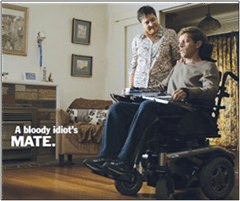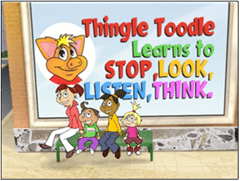This is one of the assignments from the Post Grad in Psychology of Risk being run by Dr Rob Long (more details about the course here)
Felix has given me permission to send it to you, if you think readers would be interested.
THE INFLUENCE OF VISUAL STIMULI ON THE UNCONSCIOUS by Felix Cheng – Oct 2013
In 1984, a television commercial opened to a bluish auditorium filled with robot-like men dressed alike, absorbing platitude fragments like “unification of thought” and “information purification” from a giant male face on a giant screen, the Big Brother. An unnamed heroine wearing red shorts; the only primary colour in the entire commercial and a white tank top with a cubist image of a computer on it, runs up to the screen containing Big Brother and destroys it with a sledgehammer. This was Apple’s iconic commercial introducing the Macintosh personal computer and was considered one of the best commercial ever made, yet it did not talk about the product, the company directly or about its competitor IBM (Big Brother) which was mocked by Apple. Instead, visual stimuli were used to extort the brain’s visual processing and cognitive mechanisms to show Apple’s rebelliousness to social norms and create its own social identity (Medina, 2008). It targeted those seeking a sense of social identity and Apple suggested that by having a Macintosh computer one would break away from the rigidness and conformity of society to become independent and free thinking. Can visual stimuli really prime the unconscious and influence decision-making and behaviour? Or are visual stimuli just arbitrary and its meaning relative to the culture? This paper will explore the priming effects of visual stimuli in particular pictures, symbols and words and discuss its influence on the unconscious.
Social cognitive theories suggest a subtle and potential far-reaching effect of visual stimuli that may occur outside of participants’ intention or awareness (Bargh & Morsella, 2008). Priming studies by Bargh, Chen, & Burrows (1996) have shown that complex social and physical behaviours such as aggression, loyalty, rudeness, and walking speed can be activated by relevant external visual stimuli without the person’s intent to behave that way or awareness of the influence. Furthermore, these behavourial priming effects are known to result from automatic processes requiring no effort, intentionality, or awareness (Shah, 2003). Advertisers use these well-researched priming effects to favourably influence consumers towards their product by eliciting automatic behavioural responses (Fitzsimons & Chartrand, 2008). Priming draws on the implicit class of long-term memory information to trigger a response based on process called associative activation; whereby an idea evoked triggers other connected and supportive ideas (Kahneman, 2013; Ware, 2008). For example in figure 1, automobile expos often have attractive models standing around their vehicles in the hope of lending their positive traits of beauty and desirability to the cars, therefore hoping that consumers would respond to the car the same way as they would to the attractive models associated with it.
Figure 1: Positive association of models with a vehicle
Furthermore, certain kinds of scenes, images or objects have strong emotive associations (Ware, Visual thinking for design, 2008), some of which are universal such as an image of mother and child in figure 2 have positive associations for almost everyone, therefore such images are often used to support family values or health care products.
Figure 2: Positive association of an image of mother and child
With association and priming, graphic symbols can function in the same manner as words, and can become embedded in visual culture. The athletic brand Nike with its symbolic tick is associated with traits such as “active” and “confident” which are generally seen as positive in American culture, so Nike plays a motivational role for young people, symbolizing desirable future or alternate selves (Fitzsimons & Chartrand, 2008). Therefore, the tick as a symbol is significant in the meaning that it has created, rather than what it is. Recognising an object an object can cause both physical and cognitive action patterns to be primed, therefore, seeing an object biases our brain towards particular thought and action patterns, making them more likely (Ware, 2008).
However, will the same picture in figure 1 elicit the same emotional response if shown to an African tribesman who has no cultural or perceptual relationship for a motor vehicle? Are the meaning of pictures, symbols and words simply arbitrary? There has been much debate on whether pictures and diagrams are purely conventional or are perpetual symbols with special properties. Nelson Goodman as cited in Ware (2013) argues that pictures are
the result of inculcation and any picture may represent almost anything as there is usually a plan of correlation under which the picture represents an object. Therefore, one could argue that the word dog bears no perceptual relationship to any actual animal; it is only because the representation of dog is learned through cultural and social guides. Cultural guides such as language, norms and values are imprinted during early childhood development (Bargh & Morsella,
2008), where words, objects and pictures are given meaning and context. For example, colours are often used symbolically, in Western culture, red typically represents danger, heat and stop; green represents go, safety and renewal; blue represents cold; white represents purity etc. However in China the colour red is symbolic of luck, good fortune and renewal and in most parts of Asia, white is the colour of mourning, whereas in the west it is black. Therefore, such colour meanings are culturally determined (Ware, 2008).
Figure 3: What is the meaning of AFL football in a remote African village? (Image courtesy of John Williams)
There are many examples supporting Goodman’s assertions, however studies by Ekman and Friesen (1971) on a linguistic and culturally isolated group of the South East Highlands of New Guinea were told and story and then shown a set of three faces and asking them to select the face which showed emotion appropriate to the story suggests that some human expressions are universal communication signals, which can be interpreted across cultures and social groups (figure 4).
Figure 4: Human expressions are universal communication signals
Whether it is inculcated or innate, contextual factors strongly influence how people respond to the stimulus, whether it is a geometric shape, a word, symbol or facial expression (Plous, 1993). How the stimulus is interpreted and primed also depends on the past experiences and the context in which it occurs and can invoke certain emotions and behaviours. This is operated at the unconscious level and where most implicit decision-making occurs. Long (2012) and Kahneman (2013) suggests there are different levels in which judgements are made; the conscious and unconscious and it is within the level of the unconscious that implicit knowledge and responses are formulated and retained. In the studies by Bargh et al. (1996), demonstrated automatic influence when participants were indirectly primed with words having to do with stereotypes associated with the elderly, they took longer to complete a task even though the word slow was not shown. This was an automatic behavioural effect as a result of semantic priming, a visual stimulus. Similarly, participants in a room with MasterCard insignias were spurred on spending more those participants that were not exposed to any MasterCard insignias, even though the participants were unaware of that the insignias were part of the experiment. It suggested that the participants were more likely to associate credit cards and the insignias, symbols and logos that represent them with the positive rather than the negative aspects of spending (Feinberg, 1986). Where end states that are negatively perceived by the individual, it will affect the ability of the visual stimulus to automatically trigger a response or behaviour (Fitzsimons & Chartrand, 2008). Such as Metro’s launch of the Dumb Ways to Die public service video in an attempt to change behaviour around trains (figure 5). It visually depicts cartoon characters dying through “stupid” mistakes such as getting toast out from a toaster with a fork or selling both kidneys on the Internet and words such as “dumb” and “common sense” are used on its website. Although with forty million views and one of the most awarded public service video ever made, Metro recorded its highest numbers of near misses at a level crossing this decade whilst other safety figures showed little improvement or remained the same (Transport Safety Victoria, 2013). From what is already understood about priming and association, it can be argued that the visuals within the video may inadvertently promote harm rather than prevent it.
Figure 5: Negative perception effects can affect the ability of visual stimuli to elicit the desired behaviour or response.
Victoria’s Traffic Accident Commission (TAC) launched a new chapter in its long-running “Bloody Idiot” drink driving campaign. While previous instalments focused on shock tactics and gruesome imagery, the latest commercials attempts to demonstrate the effects of drink-driving on the families and friends of “offenders” (figure 6). Similar to Metro’s Dumb Ways to Die campaign, it consists of negative associations and negative pairing of constructs with a negative outcome or reward, which according to Fitzsimons and Chartrand (2008) is less likely to elicit a behavioural response. Further more, the use of the word “bloody idiot” and its automatic association with drink driving and loss of life does not take into consideration the complexity of motivation, social psychology and decision-making. Therefore, by creating labels such as “bloody idiot” and depending on the context to the individual, it may result in negative sentiments towards the campaign.
 Figure 6: TAC’s "bloody idiot" campaign (image from TAC)
Figure 6: TAC’s "bloody idiot" campaign (image from TAC)
Conversely, a series of animated advertisements (figure 7) also by the TAC aimed at children showing aspects of how to be safe on the roads consists of key words such as “stop, look, listen, think” that primes and elicit automatic behavioural responses due to the words’ pairing of constructs and unambiguity. The words are consistent in meaning and its use vibrant colours and positive emotion represented as smiles on the characters create a positive emotional and rewarding experience as compared to the dark and bleak nature of the “bloody idiot” campaign. Although aimed to get the attention of children, the effects of visual stimuli are still pertinent to the adult unconscious.
 Figure 7: TAC’s "Stop, Look, Listen, Think” campaign (image from TAC)
Figure 7: TAC’s "Stop, Look, Listen, Think” campaign (image from TAC)
Visual stimuli have shown to elicit emotional and psychological responses which influences behaviour, perception and decision-making. Just by taking a look in our environment shows that our visual senses are saturated by it, from words, logos, to signs and colours, each having the ability to influence the unconscious, emotions and ultimately affecting decision making. In terms of risk, the use of logos, symbols and language matters, as it creates the discourse and part of the culture of an organisation. Words such as “can do” primes for hubris and encourages risk taking without the understanding of it, whilst the use of “zero” is associated with absoluteness, without compromise and perfectionism, resulting in a cultural discourse and behaviours around fundamentalism, compliance and authority (Long, 2012). Similarly, how the space of a workplace is designed can influence the unconscious. Space and structure can elicit specific emotions such as feelings of grandeur or tranquillity. Others are designed to exhibit power, strength and security such as the High Court building in Canberra (figure 8; field visit, 2013). Devoid of colour and signs, the building is symbolic of the nature and meaning of what it represents – the law. As one approaches up the incline towards the megalithic building designed purposefully comprising of asymmetric geometric shapes reflects the seriousness of the structure and it elicits feelings of power, not dissimilar to shrines and temples created by the Incas in worship of their gods. The tall vertical bars on the windows are visually representative of bars of a gaol, a reminder that this is an institution of the law.
 Figure 8: High Court building in Canberra
Figure 8: High Court building in Canberra
Within the building (figure 9), the distribution of power continue to be exhibited with the tall ceilings, raw concrete walls, and grey stone floors, with bars lining the glass, the only view of the outer environment. Visually, the grandeur of the structure, the use of shapes, symbols, materials and choice of colour imposes upon the unconscious feelings of strength, power, authority and lawfulness; a building that commands obedience and its asymmetric design symbolic of its independence from Parliament.
 Figure 9: Entrance hall of the High Court building in Canberra
Figure 9: Entrance hall of the High Court building in Canberra
The priming effects of visual stimuli influences the unconscious, so is there a defence against it? How does one know when one is being emotionally and psychology influenced and creating bias towards our decision-making? According to Cialdini (2009), it is nearly impossible to detect and deflect the many psychological influences, but can be defended by concentrating on the effects rather than the causes. By being more sensitive of own emotions, thoughts and behaviours, awareness can be made to the conscious level and be alerted when visual stimuli are exerting some influence.
In conclusion, visual stimuli such as words, images, symbols, structures and space can prime the unconscious into automatic behavioural, emotional and psychological responses that can influence decision-making. The ability and effectiveness of visual stimuli to prime the unconscious and result in automatic behaviour responses is dependent on highly specific conditions; connections and contexts between the perception input and behavioural output (Dijksterhuis & Bargh, 2001). Therefore it is important to consider the social and cultural norms when using visual primes to ensure the desired behavioural outcomes and that it is effective. The retail industry and brands have knowingly used the power of visual stimuli and its priming effects to motivate and influence consumers to buy their products or instil certain traits or associations to their brands due to the ability of the visual stimuli to influence decision- making unconsciously. More importantly, visual stimuli can influence decision- making of risk where semantics and semiotics can positively or negatively influence the behaviour and decision-making of individuals or the creation of a calculative or generative culture of an organisation.
Bibliography
Canberra spatial awareness field trip. (2013, July). Canberra.
Bargh, J. A., & Morsella, E. (2008). The Unconscious Mind. Perspective on
Psychological Science, 3(1), 73-79.
Bargh, J. A., Chen, M., & Burrows, L. (1996). Automaticity of Social Behaviour: Direct Effects of Trait Construct and Stereotype Activation on Action. Journal of Personality and Social Psycology, 71(2), 230-244.
Cialdini, R. B. (2009). Influence: science and practice. United States of Americaq:
Pearson Education.
Dijksterhuis, A., & Bargh, J. A. (2001). The Perception-Behaviour Expressway: Automatic Effects of Social Perception on Social Behaviour. Advances in Experimental Social Psychology, 33, 1-40.
Ekman, P., & Friesen, W. V. (1971). Constants across cultures in the face and emotion. Journal of personality and social psychology, 17(2), 124-129.
Feinberg, R. A. (1986, December). Credit cards as spending facilitating stimuli: a
conditoning interpretation. Journal of consumer research, 13. Fitzsimons, G. M., & Chartrand, T. L. (2008). Automatic Effects of Brand
Exposure on Motivated Behaviour: How Apple Makes You "Think
Different". Journal of Comsumer Research, 35(1), 21-35. Kahneman, D. (2013). Thinking, Fast and Slow. New York: FSG. Long, R. (2012). For the love of zero. ACT: Scotoma Press.
Long, R. (2012). Risk makes sense. ACT: Scotoma Press.
Medina, J. (2008). Brain rules. Seattle: Pear Press.
Plous, S. (1993). The psychology of judgment and decision making. USA: McGraw-Hil, Inc.l.
Shah, J. (2003). Automatic for the People: How Representations of Significant Others Implicitly Afffect Goal Pursuit. Journal of Personality and Social Psychology, 84(4), 661-681.
Simons, D. J., & Levin, D. T. (1998). Failure to detect changes to people during a
real-world interaction. Psychonomic Bulletin & Review, 644-649. Transport Safety Victoria. (2013). Quarterly incident statistics for heavy rail 2013
– 2nd quarter. Melbourne: Transport Safety Victoria.
Ware, C. (2008). Visual thinking for design. Burlington: Morgan Kaufmann. Ware, C. (2013). Information visualisation: perception for design.
Massachusetts: Morgan Kaufmann.



Do you have any thoughts? Please share them below